|
|
|
Sort Order |
|
|
|
Items / Page
|
|
|
|
|
|
|
| Srl | Item |
| 1 |
ID:
167292
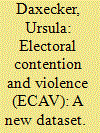

|
|
|
|
|
| Summary/Abstract |
Recent elections in Afghanistan, Bangladesh, Côte d’Ivoire, Egypt, Iraq, Kenya, Nigeria, and Pakistan have displayed substantial contestation and violence. A growing literature explores the causes and consequences of electoral contention and violence, but researchers lack comprehensive, disaggregated data establishing a substantive link between elections and violence. The Electoral Contention and Violence (ECAV) dataset conceptualizes electoral contention as nonviolent or violent events of contestation by state or non-state actors related to national elections. The data contain more than 18,000 events of election-related contention covering 136 countries holding competitive national elections between 1990 and 2012. This article describes the scope of ECAV, presents the project’s definition of electoral contention and the variables included, and outlines the coding procedure. We then compare ECAV to other datasets on electoral contention. Cross-national and subnational analyses of electoral competition and violence show that the data are useful for assessing the global and subnational implications of existing theories. ECAV addresses current data limitations by focusing on election-related contention, by using clear criteria to determine whether events are election-related, and by identifying the timing, geocoded location, and actors involved.
|
|
|
|
|
|
|
|
|
|
|
|
|
|
|
|
| 2 |
ID:
178623
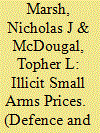

|
|
|
|
|
| Summary/Abstract |
Despite calls to reduce illicit arms flows, it remains difficult to detect and quantify them. One proposed method for detecting and quantifying illicit trade volumes is to test econometrically for price changes. This paper documents an effort of the Peace Research Institute Oslo (PRIO) and the Small Arms Data Observatory (SADO) to make such inferential econometric analyses possible by assembling two new datasets on illicit small arms prices. The first, called the ‘Illicit Small Arms Prices – Transactions’ dataset (iSAP-T), has an observational unit of arm(s) sold in a single transaction. The second, called the ‘Illicit Small Arms Prices – Countries’ dataset (or iSAP-C), derives from the iSAP-T and has the more standard country-year observational unit. This paper describes the methods for data collection, organization, and generation for these datasets, presents some descriptive statistics and graphics, and concludes with a discussion of possible future uses and limitations of the datasets.
|
|
|
|
|
|
|
|
|
|
|
|
|
|
|
|
| 3 |
ID:
166005
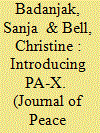

|
|
|
|
|
| Summary/Abstract |
This article introduces PA-X, a peace agreement database designed to improve understanding of negotiated pathways out of conflict. PA-X enables scholars, mediators, conflict parties and civil society actors to systematically compare how peace and transition processes formalize negotiated commitments in an attempt to move towards peace. PA-X provides an archive and comprehensive census of peace agreements using a broad definition to capture agreements at all phases of peace processes in both intrastate and interstate conflict, from 1990 to 2016. These comprise ceasefire, pre-negotiation, substantive (partial and comprehensive), and implementation agreements, disaggregated by country/entity, region, conflict type, agreement type and stage of agreement totalling over 1,500 agreements in more than 140 peace and transition processes. PA-X provides the full text of agreements, and qualitative and quantitative coding of 225 categories relating to politics, law, security, development and implementation. Data can be aggregated or merged with conflict datasets, effectively providing many datasets within one database. PA-X supports new comparative research on peace agreements, but also on peace processes – enabling tracing of how actors and issues change over time – to inform understandings of conflict termination. We illustrate PA-X applications by showing that an intricate peace process history correlates with reduced likelihood of conflict recurrence, and that cumulative provisions addressing elections see the quality of subsequent post-conflict elections improve.
|
|
|
|
|
|
|
|
|
|
|
|
|
|
|
|
| 4 |
ID:
107659
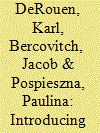

|
|
|
|
|
| Publication |
2011.
|
| Summary/Abstract |
Mediation is one of the few mechanisms the international community can deploy that will affect civil wars. This article introduces the dataset on mediation in civil wars - termed the Civil War Mediation (CWM) dataset. This is the first dataset to focus solely on civil war mediation. These data contribute to the present state of quantitative research on mediation in three important respects: the data are collected for the period of 1946-2004, are organized by mediation cases and by civil war episode, and provide detailed information about mediation incidences. The article first presents a few variables included in the dataset that are motivated by theoretical arguments from the literature. After a presentation of summary statistics, attention is turned to using the CWM data to explore the determinants of mediation. Mediation is shown to be a function of war type (territorial and internationalized wars are more likely to be mediated), war duration (the longer the war the higher the probability of mediation), supply-side factors (the number of democracies in the world and the global polity average), and stratum (subsequent wars are less likely to be mediated). Battle-related deaths also seem to increase the chances of mediation, though the relationship is only weakly significant. The article concludes with suggestions for future research that can benefit from the dataset.
|
|
|
|
|
|
|
|
|
|
|
|
|
|
|
|
| 5 |
ID:
193116


|
|
|
|
|
| Summary/Abstract |
This article introduces the Civil Conflict CeaseFire (CF) dataset. The CF data covers all ceasefires in civil conflict between 1989 and 2020, including multilateral, bilateral and unilateral arrangements, ranging from verbal arrangements to detailed written agreements. In total, the CF data includes 2202 ceasefires across 66 countries and 109 civil conflicts. The data feature information on the actors involved in the ceasefire, and the class, purpose, coverage, and end date of the ceasefire. The CF data provide an empirical basis to assess the conditions that give rise to ceasefires, how ceasefires affect the dynamics of conflict, and the role of a ceasefire in the peace process. This article presents the rationale underlying the data collection, the coding rules and procedures, and how this data can be used for analysis.
|
|
|
|
|
|
|
|
|
|
|
|
|
|
|
|
| 6 |
ID:
189966
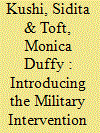

|
|
|
|
|
| Summary/Abstract |
While scholars have made many claims about US military interventions, they have not come to a consensus on main trends and consequences. This article introduces a new, comprehensive dataset of all US military interventions since the country’s founding, alongside over 200 variables that allow scholars to evaluate theoretical propositions on drivers and outcomes of intervention. It compares the new Military Intervention Project (MIP) dataset to the current leading dataset, the Militarized Interstate Disputes (MID). In sum, MIP doubles the universe of cases, integrates a range of military intervention definitions and sources, expands the timeline of analysis, and offers more transparency of sourcing through historically-documented case narratives of every US military intervention included in the dataset. According to MIP, the US has undertaken almost 400 military interventions since 1776, with half of these operations undertaken between 1950 and 2019. Over 25% of them have occurred in the post-Cold War period.
|
|
|
|
|
|
|
|
|
|
|
|
|
|
|
|
| 7 |
ID:
122903
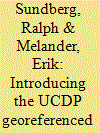

|
|
|
|
|
| Publication |
2013.
|
| Summary/Abstract |
This article presents the UCDP Georeferenced Event Dataset (UCDP GED). The UCDP GED is an event dataset that disaggregates three types of organized violence (state-based conflict, non-state conflict, and one-sided violence) both spatially and temporally. Each event - defined as an instance of organized violence with at least one fatality - comes with date, geographical location, and identifiers that allow the dataset to be linked to and merged with other UCDP datasets. The first version of the dataset covers events of fatal violence on the African continent between 1989 and 2010. This article, firstly, introduces the rationale for the new dataset, and explains the basic coding procedures as well as the quality controls. Secondly, we discuss some of the data's potential weaknesses in representing the universe of organized violence, as well as some potential biases induced by the operationalizations. Thirdly, we provide an example of how the data can be used, by illustrating the association between cities and organized violence, taking population density into account. The UCDP GED is a useful resource for conflict analyses below the state and country-year levels, and can provide us with new insights into the geographical determinants and temporal sequencing of warfare and violence.
|
|
|
|
|
|
|
|
|
|
|
|
|
|
|
|
| 8 |
ID:
146929
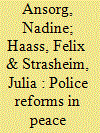

|
|
|
|
|
| Summary/Abstract |
This article presents new data on provisions for police reform in peace agreements (PRPA) between 1975 and 2011. The PRPA dataset complements past research on the determinants and effects of specific terms in agreements with detailed data on police reform provisions. The PRPA dataset also adds a quantitative dimension to the thus far largely qualitative literature on post-conflict security sector reform (SSR). It includes information on six subtypes of police reform: capacity, training, human rights standards, accountability, force composition and international training and monitoring. We show that there is currently a high global demand for the regulation of police reform through peace agreements: police reform provisions are now more regularly included in agreements than settlement terms that call for power-sharing or elections. We observe interesting variations in the inclusion of police reform provisions in relation to past human rights violations, regime type, or the scope of international peacekeeping prior to negotiations, and illustrate the implications of police reform provisions for the duration of post-conflict peace. Finally, we stimulate ideas on how scholars and policymakers can use the PRPA dataset in future to study new questions on post-conflict police reform.
|
|
|
|
|
|
|
|
|
|
|
|
|
|
|
|
| 9 |
ID:
180203
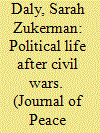

|
|
|
|
|
| Summary/Abstract |
Around the world, following civil wars, rebel and government belligerents contest and win the founding postwar elections. Despite the prevalence of these elections and their importance in setting post-conflict environments on specific political trajectories, their outcomes have been understudied. Existing scholarship centers on the timing and institutions of the postwar elections, but not on their party and voter participants. This article introduces a dataset which traces the postwar political trajectories of civil war belligerents, identifies their successor parties, charts their electoral performance, and documents their decision to remilitarize or demilitarize. The Civil War Successor Party (CWSP) dataset covers all belligerents that have transitioned from civil conflict in the period 1970–2015. The article describes the contours of the dataset, reveals patterns of political life after wars, and outlines the potential uses of the dataset for future research. In particular, it suggests how the data may be leveraged by scholars and practitioners to understand dynamics of political behavior, patterns of governance and public goods provision, quality of democracy, and recurrence of low- and high-intensity war in the aftermath of mass violence.
|
|
|
|
|
|
|
|
|
|
|
|
|
|
|
|
| 10 |
ID:
167293
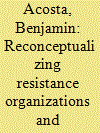

|
|
|
|
|
| Summary/Abstract |
In recent years, scholars of various forms of conflict involving revolutionary and militant organizations (such as terrorism, civil war, and nonviolent contestation) recognized that arbitrary organizational categories and typologies often leave large-N studies incomplete and biased. In moving away from nominal categorical boundaries that produce such selection biases and looking to a more generalized conception of resistance organizations, I constructed an original dataset that aims to bridge the gap between conflict literatures. Transcending traditional classifications, the Revolutionary and Militant Organizations dataset (REVMOD) consists of over 500 resistance organizations operative sometime between the years 1940 and 2014 and includes a diverse array of types of resistance organizations – many of which utilize a multitude of tactics, operate in various conflict contexts, and/or confront numerous target types. The dataset documents organizational attributes, allies, and adversaries at annual intervals (organization-years), making reliable time-series analyses possible. Tracking variables like organizational outcome-goal type and degree of achievement, political capacity, leader/s, constituent identity group, violence and demonstration levels, size, organization aliases, and several others, REVMOD breaks new ground in the collection of information on resistance organizations and can spur countless studies. A preliminary data analysis demonstrates that differences in organizational political capacity explain variation in resistance outcomes generally and in particular contexts such as civil war, terrorism, and nonviolent revolutions. REVMOD provides a unique opportunity to develop a new research paradigm for resistance studies that employs large-N empirical analyses to uncover generalities between different forms of political contention in the contemporary era, as well as to better understand why and how distinct resistance processes may produce specific outcomes.
|
|
|
|
|
|
|
|
|
|
|
|
|
|
|
|
| 11 |
ID:
121801
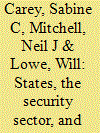

|
|
|
|
|
| Publication |
2013.
|
| Summary/Abstract |
This article introduces the global Pro-Government Militias Database (PGMD). Despite the devastating record of some pro-government groups, there has been little research on why these forces form, under what conditions they are most likely to act, and how they affect the risk of internal conflict, repression, and state fragility. From events in the former Yugoslavia, Iraq, Sudan, or Syria and the countries of the Arab Spring we know that pro-government militias operate in a variety of contexts. They are often linked with extreme violence and disregard for the laws of war. Yet research, notably quantitative research, lags behind events. In this article we give an overview of the PGMD, a new global dataset that identifies pro-government militias from 1981 to 2007. The information on pro-government militias (PGMs) is presented in a relational data structure, which allows researchers to browse and download different versions of the dataset and access over 3,500 sources that informed the coding. The database shows the wide proliferation and diffusion of these groups. We identify 332 PGMs and specify how they are linked to government, for example via the governing political party, individual leaders, or the military. The dataset captures the type of affiliation of the groups to the government by distinguishing between informal and semi-official militias. It identifies, among others, membership characteristics and the types of groups they target. These data are likely to be relevant to research on state strength and state failure, the dynamics of conflict, including security sector reform, demobilization and reintegration, as well as work on human rights and the interactions between different state and non-state actors. To illustrate uses of the data, we include the PGM data in a standard model of armed conflict and find that such groups increase the risk of civil war.
|
|
|
|
|
|
|
|
|
|
|
|
|
|
|
|
| 12 |
ID:
190994
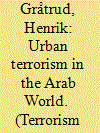

|
|
|
|
|
| Summary/Abstract |
Few regions have been more plagued by terrorism than the Arab world. However, knowledge of the phenomenon’s nature is limited by a lack of attack plot data for most Arab countries. This article contributes to addressing this gap by presenting a dataset of jihadist incidents in Jordan from 1994 until the end of 2018. Based on recent progress in measuring terrorism, the dataset does not only include launched attacks but also foiled and failed attack plots to give a more accurate and comprehensive overview of the threat. It provides answers to fundamental descriptive questions such as how many plots there have been, which jihadist actors have been responsible, and what type of attacks they have attempted to carry out. This work matters because it reveals the main characteristics of the jihadist terrorist threat to the Kingdom. This enables future studies to provide more empirically based explanations of what causes jihadist terrorism in Jordan than previously possible.
|
|
|
|
|
|
|
|
|
|
|
|
|
|
|
|
|
|
|
|
|